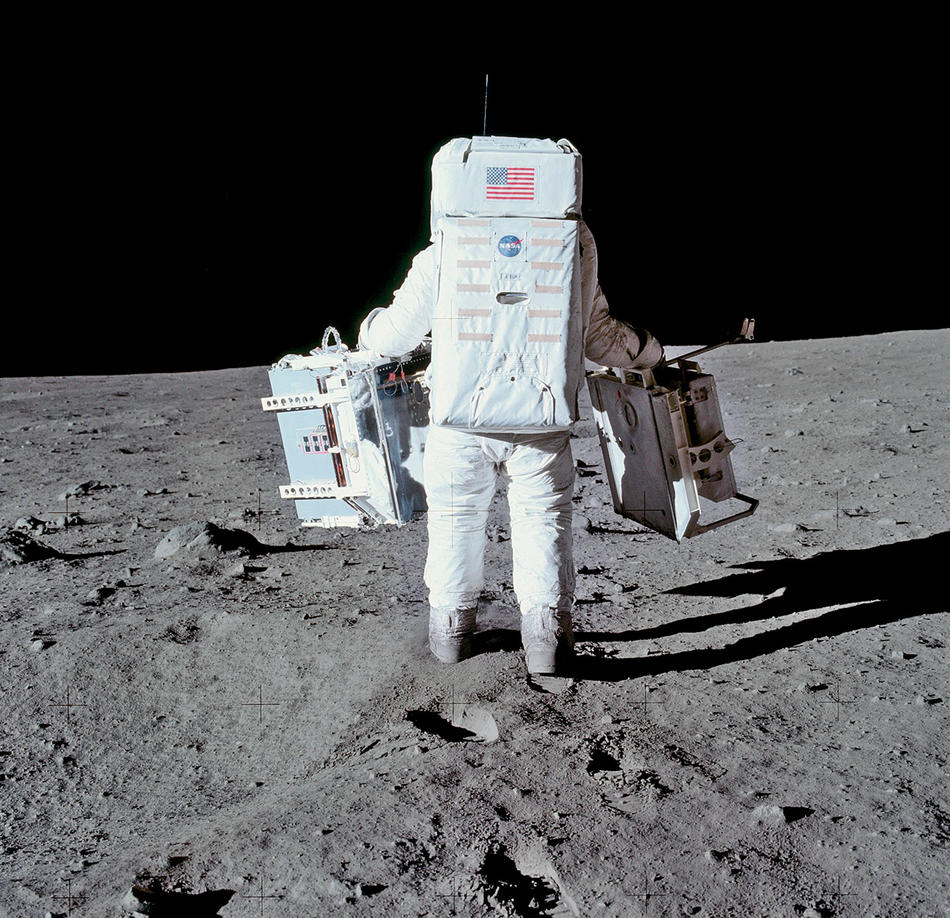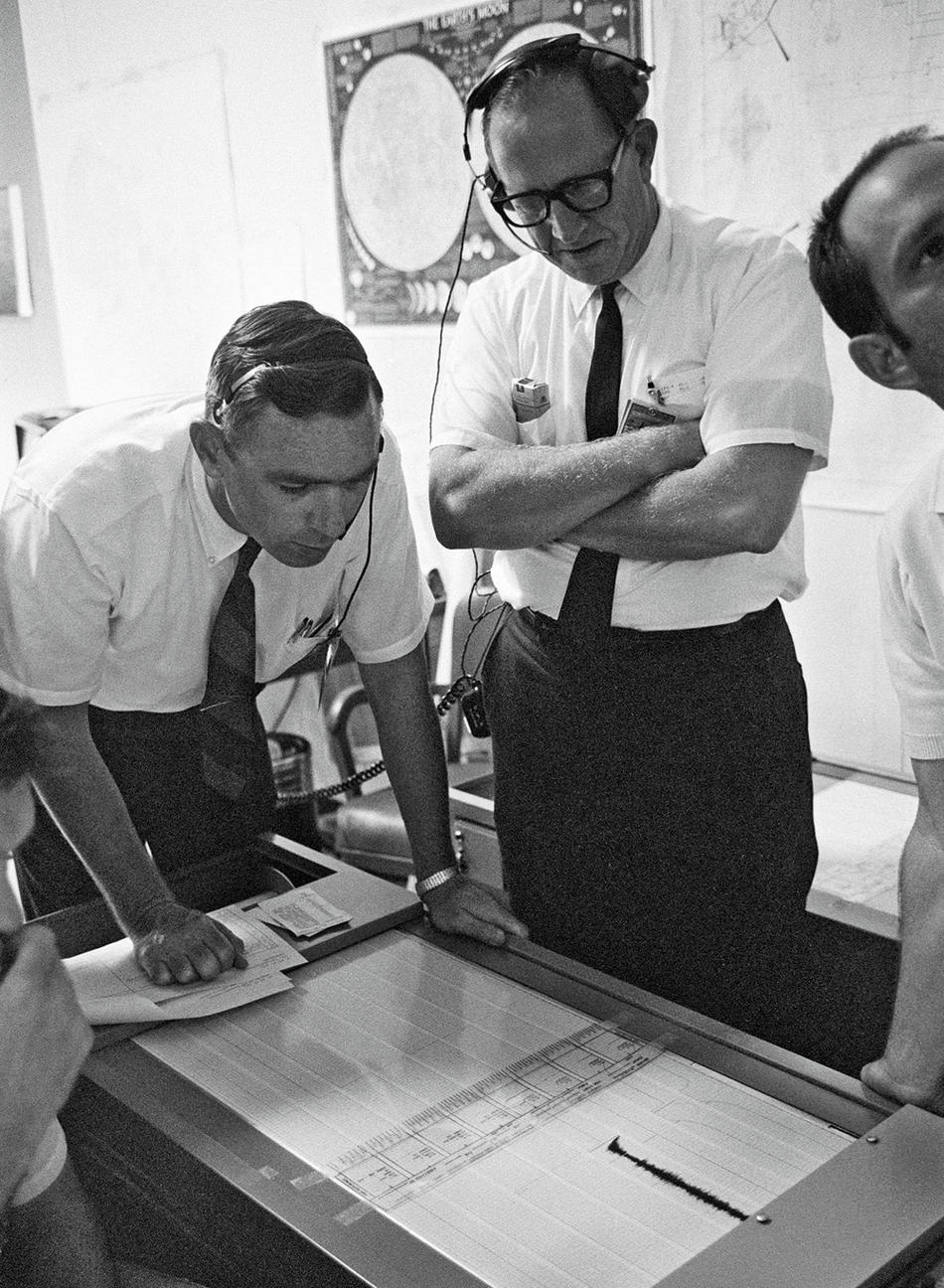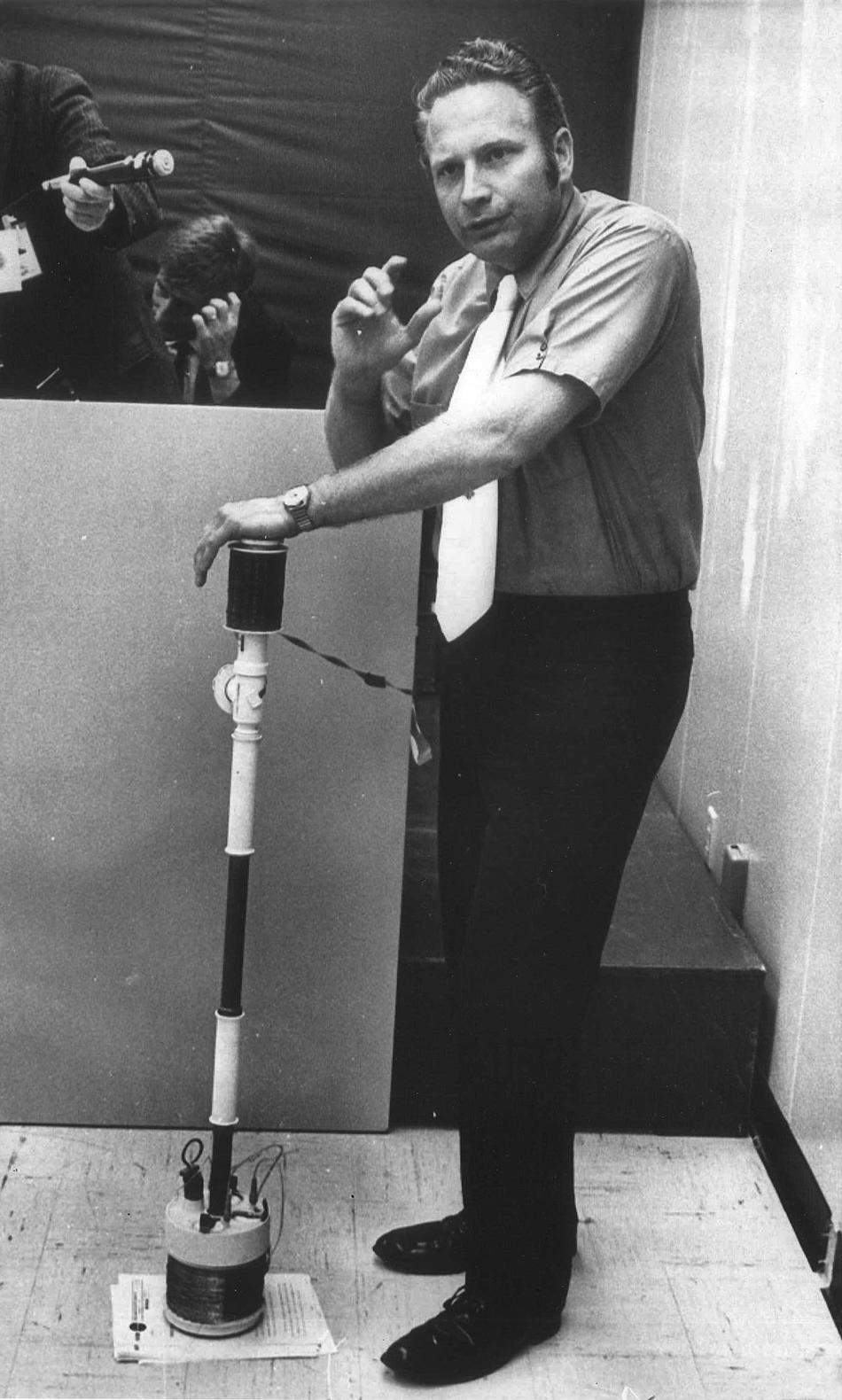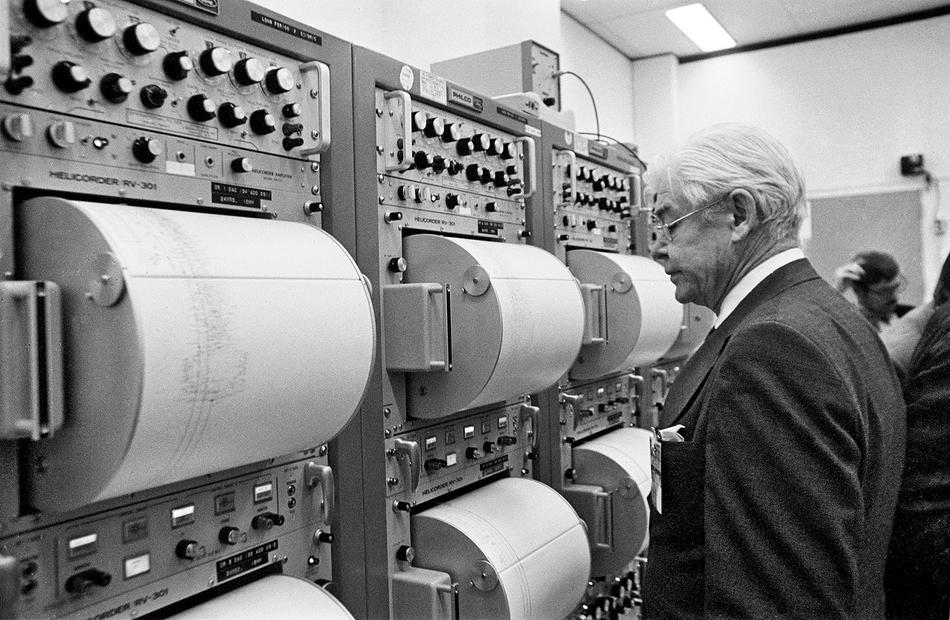
On the afternoon of July 20, 1969, Gary Latham ’65GSAS, a thirty-three-year-old geophysicist at Columbia’s Lamont-Doherty Geological Observatory, arrived at NASA’s Manned Spaceflight Center (now the Johnson Space Center) in Houston to witness the fulfillment of thousands of years of curiosity and wonder: humanity’s first attempt to land men on the moon.
Four days earlier, Latham, along with millions of others around the world, had stared rapt at a TV screen as a 363-foot-tall Saturn V rocket lifted off in a Zeusian thundercloud from Cape Canaveral. Atop the rocket was the Apollo 11 spacecraft, carrying astronauts Neil Armstrong, Edwin “Buzz” Aldrin, and Michael Collins. Also onboard, but attracting a lot less attention, was the Passive Seismic Experiment Package (PSEP), a system of four solar-powered seismometers that Latham had developed for the mission.
At training sessions in Clear Lake, Texas, Latham had shown the astronauts exactly how to rig PSEP, which would measure the seismic waves caused by disturbances of the lunar surface, whether from meteorites or — if such things existed — moonquakes. The readings would provide the first scientific glimpse into the interior properties of the moon and help tackle questions as old as time: what was the moon’s structure, its composition, its origin, its history?
But first the spacecraft had to land. As the Apollo 11 crew, 240,000 miles away, prepared their next precision maneuver, Latham registered the intense focus and bottled-up emotion at Mission Control. Cigarette smoke hung thick over the beige consoles, with their red and yellow buttons and cathode-ray-tube monitors. On the front wall, a screen marked the progress of the flight on a plotted graph.
Latham was one of an army of Columbians gathered at the complex in Houston that day. Astrophysicist Robert Jastrow ’44CC, ’48GSAS was the first chairman of NASA’s Lunar Exploration Committee and, with Nobel-winning chemist Harold Urey ’46HON, had pushed lunar science to the fore at NASA in the 1950s. Wilmot “Bill” Hess ’46SEAS was director of science and applications for Project Apollo and spent much of the time in a side room monitoring the sun for flares, which could harm the astronauts. Geologist Donald Beattie ’51CC was program manager for the Apollo lunar-surface experiments (including Latham’s). And Robert Kovach ’59GSAS was the principal investigator on the seismic experiments that would go up on later Apollo missions — provided, of course, that all went well with this one.
“At the time of the experiments we didn’t know anything about the near-surface properties of the moon,” says Kovach, eighty-five, who is professor emeritus at Stanford. “The biggest argument among the scientists in the early days was whether the craters seen on the moon were impact craters or volcanic craters. The reason NASA brought geologists into Project Apollo was to resolve that basic question.”
NASA’s effort to put seismometers on rockets and land them on the lunar surface had been in the works since 1959. It started with the Ranger program, which sent unmanned spacecraft to take the first close-up photographic images of the moon. Geophysicist Frank Press ’49GSAS, ’90HON, who left Lamont in 1957 to run the seismology lab at Caltech, created seismometers for Ranger 3, 4, and 5 that were to be dropped on the lunar surface. Each instrument was encased in a balsa-wood ball and designed to separate from the rocket once the moon’s gravity was strong enough to reel it in. But mechanical glitches sent Ranger 3 and 5 off-course, missing the moon entirely, and the failure of an onboard computer caused Ranger 4 to crash on the far side of the moon.
The follow-up program to Ranger was Surveyor, which began in 1966. Surveyor would launch space probes to test the practicality of soft landings on the moon. Again, NASA wanted to send up a seismometer. This time, it enlisted help from Lamont, and specifically Maurice “Doc” Ewing, Lamont’s founding director. Ewing had virtually invented modern marine geoscience, and in the 1940s, with his then student Press, he developed the first mass-produced seismograph, called the Press-Ewing. A Texas farmer’s son and a self-described “big, rough-looking character,” Ewing embodied the fieldwork-driven, data-amassing, non-theoretical scientific explorer. He was the first person to study the ocean floor using seismic waves, and in 1953 he procured a research vessel, Vema, on which he made dozens of expeditions, setting off dynamite, collecting core samples, and revealing to the world the physical properties of the ocean floor.
Latham’s role at NASA began one day in 1965. “I was walking down the hall in the geoscience building at Lamont, and Doc Ewing pulled me aside,” says Latham, who is eighty-three and lives in St. Augustine, Florida. “He said, ‘How would you like to put an instrument on the moon?’ At first I thought he was joking. The moon? But he was serious. I said, ‘Sounds exciting.’ And we got to work.”
No sooner had they started than NASA raised the ante. Latham had assumed that any lunar seismometer would go up on an unmanned rocket. But in 1966, NASA decided that the Surveyor seismometers would fly with the Apollo program, whose stated goal — echoing President John F. Kennedy’s 1962 speech — was for the US to land humans on the moon and bring them back safely, and to accomplish this before the decade was out. NASA now wanted the Lamont team to design an instrument that astronauts could actually carry and set up. Such an instrument would have to make minimal demands on the astronauts’ limited time; be adjustable by remote control from Earth; withstand extreme temperatures; and send data by radio telemetry back to Houston, where a seismograph would translate the signals into lines on paper.
Latham was happy just to be part of it. As a kid growing up in Bucks County, Pennsylvania, he had wanted to be a physicist until an undergraduate course in geology at Penn State inspired him to combine the two disciplines. Geophysics entailed more fieldwork than physics, and that suited Latham. Now he was thriving in Ewing’s lab, and Ewing persuaded NASA that Latham, the junior member of the team, should be the principal investigator, or PI. “I was at the right place at the right time,” Latham says, “and Ewing really lent his weight to having one of his students be a major part of the project.”
What made the choice even more remarkable was that the PI post was coveted. As Donald Beattie wrote in his book Taking Science to the Moon: Lunar Experiments and the Apollo Program, PIs, in addition to being the lead scientists, “also got the publicity and all the other notoriety that went with this high-profile position … How many scientists could look forward to saying they had designed an experiment that was placed on the Moon by the astronauts? Everyone knew only a lucky handful would have this claim to fame.”
The seismometer system that Latham devised weighed 106 pounds on Earth but would weigh one-sixth of that, about eighteen pounds, on the moon. To protect the instrument from temperatures ranging from 260°F during the lunar day (which lasts 13.5 Earth days) to -280°F during the lunar night, the team shrouded it in layers of aluminized Mylar and provided radioisotope heaters. Seismometers were sensitive devices, and the lunar environment would enhance this sensitivity to unimagined levels.
“The moon has no noise — no wind, no ocean, no human activity,” Latham explains. “That means we could pick up vibrations on the moon much smaller than anything we could possibly detect on Earth. It’s a kind of magnification: the data that we see recorded on chart paper show vibrations that are ten million times larger than those that actually occurred at the lunar surface. This turned out to be a very favorable factor for seismic experiments on the moon.”
Just after 4 p.m. EDT, a problem occurred, and the doors to Mission Control were ordered locked. The lunar module, Eagle, carrying astronauts Armstrong and Aldrin, had overshot the landing area and was now skimming above a football-field-sized crater full of rocks the size of Volkswagens. With fuel running out, Armstrong took manual control of the bug-like craft and guided it to a patch of flat terrain. At 4:18 p.m. EDT, Eagle’s struts touched the lunar grit. Inside Mission Control, Armstrong’s voice crackled from the speakers: “Houston, Tranquility Base here. The Eagle has landed.”
The force of the exhalations released in Houston was itself seismic. In the Mission Control viewing room, cheers broke out.
For Robert Kovach, the scientific journey was about to begin. His own experiments for future Apollo missions 14, 16, and 17 were in many ways contingent upon the feasibility of Latham’s work. Like the Latham experiment, Kovach’s would measure the velocities, frequencies, and amplitudes of seismic waves moving through rock. Only instead of impacts from meteorites, the source of the waves would be controlled explosions.
“It took many years to get these experiments developed and built and certified,” says Kovach. “There were all kinds of safety problems with using explosives on the moon with the astronauts walking around — you can imagine. People were balking at the time.”
Kovach’s path to the moon began when he was a kid in Los Angeles. At fifteen, he saw a movie called Lust for Gold, about a legendary hidden gold mine. He became obsessed with mines. In those days, a Greyhound bus could take you out to the boonies in no time, and on weekends Kovach would ride out to the abandoned gold mines in the high desert above LA to scout around. That was how he got interested in geology.
He enrolled in the Colorado School of Mines, and after he graduated he went to Columbia for his master’s. In the summer of 1955, he went to sea on Vema with Doc Ewing. His studies in seismology were disrupted in 1956 when the Suez Crisis broke out and he was called to serve in the Army Corps of Engineers. Two years later he returned to Lamont, graduating in 1959. Then he went to Caltech to work with Frank Press.
Now, as a PI for Project Apollo, Kovach found that his most important resources were patience and perseverance. “There was a lot of pushing and shoving among all the investigators and the people in Houston,” Kovach says. “We were taking time from the astronauts to do different tasks, and there was a tradeoff of payload weight and how much weight you could have for the experiments, and how much time the astronauts would devote to doing the experiments rather than just taking pictures. There were arguments over whose experiment was most important, that sort of thing. All of that had to be massaged out.”
On July 20, 1969, however, the wrangling had been set aside. The awesome scale of the mission, the unimaginable effort brought to bear, the ever-present dangers — these realities had a way of diminishing differences.
At 10:56 p.m. EDT, the large TV monitor in Mission Control showed the shadowed figure of Neil Armstrong, commander of Apollo 11, lowering himself from the ladder of Eagle. Armstrong touched his boot to the ground, which he found to be powdery. CBS anchor Walter Cronkite, speaking over the images, said, simply, “Armstrong is on the moon. Neil Armstrong, thirty-eight-year-old American, standing on the surface of the moon.”
At Mission Control, while people slapped backs and wiped tears, Gary Latham slipped into a side room where the seismograph was set up. There he waited for the astronauts to deploy his experiment. Confident as he was, he knew that in a supremely ambitious endeavor such as this one in the harshness of space, the unknowns far outweighed the knowns. “With the rush to get ourselves to the moon by the end of the decade, you wondered how safe the astronauts really were, and you wondered if we could really develop the instrument in its final form and have it successfully put onto the surface. We were pushing.”
Latham stared at the seismograph’s pens and the straight lines they were making on the paper. Then, shortly before midnight Houston time, the pens began to twitch and scratch. Up there, on the windless, desolate moon, the instrument was picking up the vibrations of Buzz Aldrin’s footsteps.
Latham felt like he was floating.
“We then knew we had a working instrument, and that astronauts could deliver it,” Latham recalls. “It’s really hard to describe the kind of exhilaration you feel in those circumstances, when you actually get a success.”
With six Apollo moon landings between 1969 and 1972, knowledge of Earth’s lone natural satellite expanded by orders of magnitude. Latham’s seismometers picked up hundreds of meteor strikes (lacking an atmosphere, the moon has no shield from cosmic debris) — impacts that clearly accounted for the moon’s pocked and battered shell and the pulverized grit that covers it.
At Lamont, geophysicist Orson Anderson and geochemist Paul Gast ’57GSAS analyzed samples from the hundreds of pounds of lunar rocks and soil hauled home by the astronauts. Comparing the rocks to those in “the lava fields in Hawaii,” Anderson confirmed the presence of glass particles that had been generated by meteor impacts and ancient volcanoes. And though the moon was not, as it turned out, made of cheese, Anderson, stirring the pot, compared the seismic velocities — the rate at which waves travel through a medium — of lunar rocks and cheddar. He found that the moon was, seismically speaking, closer to cheese than it was to schist or slate.
Gast, for his part, felt that NASA was undervaluing the rocks. He decried the inadequate care paid to the lunar samples, arguing that the rocks were not mementos or curiosities but geological treasures worthy of serious analysis. NASA responded by naming Gast head of its division of lunar and earth sciences. Gast died in 1973 at age forty-three, but his push for state-of-the-art storage and processing of the rocks was rewarded in 1979 with the opening of the Lunar Sample Laboratory Facility at the Johnson Space Center, where most of the rocks reside today.
The seismic experiments, meanwhile, cracked open the moon’s interior. They revealed a differentiated body, like Earth’s, with a crust, mantle, and small core. Scientists had debated whether the moon had any tectonic activity, and in the moon’s windless, lifeless environment, Latham’s instrument picked up subtle vibrations that weren’t from any meteors. These were moonquakes. Yes, they existed, and not a few bets were lost.
“Moonquakes aren’t like earthquakes,” says Latham. “Most are so small as to be imperceptible to an astronaut standing on the epicenter.” Latham found that the quakes were more pronounced when the moon passed nearest to Earth in the course of its 27.3-day orbit. “The quakes are caused by the gravitational expansion and contraction of the moon as it circles Earth,” Latham says. “That flexing is concentrated near the partially molten zone in the moon’s core. It’s like squeezing a tennis ball in and out. And if you have a partially molten zone in the interior, that’s where the stress builds up. That’s what causes these little moonquakes.”
Latham’s experiments would also benefit from one of a geophysicist’s greatest luxuries: foreknowledge of a seismic event. In December 1969, after the crew of Apollo 12 left the moon and returned to the command module, the lunar module’s ascent stage was jettisoned purposely into the moon’s surface, creating shock waves that lasted nearly an hour. In April 1970, the Apollo 13 moon landing was aborted after the rupture of an onboard oxygen tank, and as the imperiled astronauts returned safely to Earth, the spent rocket booster fell to the moon, crashing eighty-four miles from the seismometers. The waves took longer to reach the seismometers than expected, leading Latham to posit that the lunar crust was much thinner than supposed, averaging about forty miles from surface to mantle.
For many scientists, the Apollo program was terminated too soon. But it did go out with a bang. In December 1972, Apollo 17 astronauts Harrison Schmitt (a geologist, the first trained scientist in space) and Gene Cernan, the last moonwalkers, had to perform a particularly delicate task: planting explosives for Kovach’s final seismic experiment.
“The Apollo 17 astronauts had to physically take these charges and put them on the roving vehicle and drive out to the geological sites to place them,” says Kovach. “The charges had triple redundancy built into them, using pull rings and mechanical timers. The third pull ring released the firing pin that initiated a thermal battery, which could receive a signal from the central station to fire.” On Apollo 14 and 16, astronauts set off some twenty small explosions while they were on the moon, but on Apollo 17 the detonations were timed to go off after the astronauts left. “It was very complex and safe,” Kovach says. “We were nervous that it was so complicated that it might not work, but all the charges went off, so it was a successful experiment.”
Most strikingly, the waves from the blasts didn’t die down the way they would on Earth. “The signals from the moon rang for a very long time,” says Kovach. “In the earth, waves die because of the attenuation properties of rocks, due to moisture — the waves get absorbed and don’t travel so far. But on the moon they just kept reverberating.”
Maurice Ewing memorably described the lingering vibrations from the man-made lunar impacts: “It’s as though one had struck a bell, say, in the belfry of a church a single blow, and found that the reverberation from it continued for thirty minutes.”
Latham’s Apollo 11 seismic experiment lasted for twenty-one days. He also oversaw the more sophisticated systems that were sent up on later missions. In 1972 Doc Ewing left Lamont to found a geophysics institute at the University of Texas Medical Branch in Galveston, and Latham went with him. The seismic experiment that they’d worked on together operated continuously, feeding data back to Earth until 1977, when the budget ax fell. Latham was laid low. “Painful,” he says, recalling the day he threw the switch that deactivated the equipment on the moon.
Today, interest in lunar exploration is heating up again. Technology entrepreneurs like Elon Musk and Jeff Bezos want to create permanent human bases on the moon, and scientists are going back to the Apollo data trove. The voluminous files have been digitized, allowing researchers to reinterpret the findings using new technology. The pioneering work of Columbia scientists, the plinth on which lunar geophysics stands, is being rediscovered and reexamined.
And it all began with the first steps on another world — and their reverberations.
“For people like us, who were involved in the project for many years,” says Kovach, “the moon landing was a great culmination. We were tremendously excited about it at the time. And we still are.”
This article appears in the Summer 2019 print edition with the title "Blue Moon."






